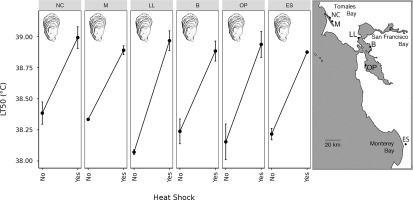Comparative Biochemistry and Physiology A: Molecular & Integrative Physiology ( IF 2.1 ) Pub Date : 2019-09-04 , DOI: 10.1016/j.cbpa.2019.110563 Jillian M Bible 1 , Tyler G Evans 2 , Eric Sanford 1

|
An organism's ability to cope with thermal stress is an important predictor of survival in a changing climate. One way in which organisms may acclimatize to thermal stress in the short-term is through induced thermotolerance, whereby exposure to a sublethal heat shock enables the organism to subsequently survive what might otherwise be a lethal event. Whether induced thermotolerance is related to basal thermotolerance is not well understood for marine organisms. Furthermore, whether populations often differ in their capacity for induced thermotolerance is also unclear. Here, we tested for differences in basal thermotolerance and induced thermotolerance among six populations of Olympia oysters (Ostrea lurida) from three California estuaries. Oysters were raised under common-garden laboratory conditions for a generation and then exposed to two treatments (control or sublethal heat shock) followed by a spectrum of temperatures that bound the upper critical temperature in order to determine LT50 (temperature at which 50% of the population dies). All populations exhibited induced thermotolerance by increasing their LT50 to a similar maximum temperature when extreme thermal stress was preceded by a sublethal heat shock. However, populations differed in their basal thermotolerance and their plasticity in thermotolerance. Populations with the highest basal thermotolerance were least able to modify upper critical temperature, while the population with the lowest basal thermotolerance exhibited the greatest plasticity in the upper critical temperature. Our results highlight that populations with high basal thermotolerance may be most vulnerable to climate warming because they lack the plasticity required to adjust their upper thermal limits.
中文翻译:

奥林匹亚牡蛎种群之间诱导的耐热性的差异。
生物体应对热应激的能力是在不断变化的气候中生存的重要预测指标。生物可以在短期内适应热应激的一种方式是通过诱导的耐热性,从而暴露于亚致死性热冲击下使生物随后能够幸免于其他可能致命的事件。对于海洋生物而言,诱导的耐热性是否与基础耐热性有关还不是很清楚。此外,还不清楚人群诱导耐热性的能力是否经常不同。在这里,我们测试了奥林匹亚牡蛎(Osrea lurida)六个种群的基础耐热性和诱导耐热性的差异),来自加利福尼亚的三个河口。将牡蛎在普通的实验室条件下饲养一代,然后进行两次处理(对照或亚致死热冲击),然后进行一系列限定上限临界温度的温度的测定,以确定LT 50(50%的温度人口死亡)。所有人群均通过增加其LT 50表现出诱导的耐热性当极端热应力之前发生亚致死热冲击时,温度会升至相似的最高温度。但是,种群的基本耐热性和耐热性的可塑性不同。基本耐热性最高的群体修改上临界温度的能力最差,而最低耐热性的群体在最高临界温度下表现出最大的可塑性。我们的结果表明,具有较高基础耐热性的人群可能最容易受到气候变暖的影响,因为它们缺乏调节上限温度所需的可塑性。











































 京公网安备 11010802027423号
京公网安备 11010802027423号